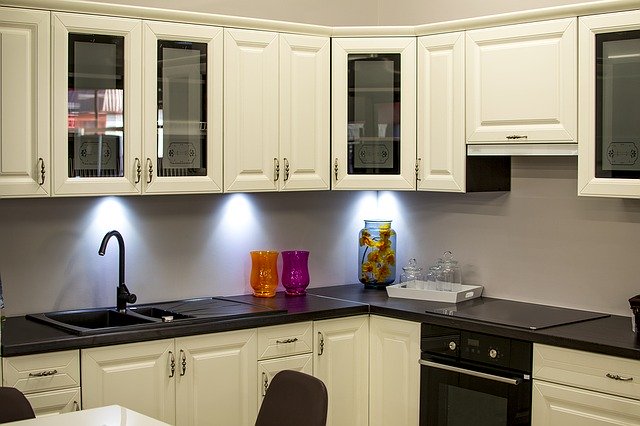Fitted kitchen

|
Contents |
[edit] Introduction
A fitted kitchen is a kitchen layout (usually domestic) [1] that typically involves a streamlined arrangement of cupboards under a continuous worktop complemented by wall cabinets (matching). The worktop usually has a built-in sink and may feature a built-in gas or electric hob, while spaces below the worktop may include integrated ovens, washing machines and dishwashers. They are sometimes referred to as ‘built-in’ kitchens. Their appearance is typically one of modular neatness and co-ordination.
Worktops are usually arranged according to the space available: a long narrow kitchen may have a ‘galley’ [2] layout with units and worktops arranged linearly on either one or both sides. If there is more space, the worktop can take the form of a peninsula – accessible on three sides. Larger kitchens can usually accommodate various arrangements of worktops such as an ‘island’ – a free-standing worktop with units below or a breakfast bar.
[edit] A brief history
Before fitted kitchen, arrangements would typically consist of freestanding elements – cupboards, range cookers and ovens, dressers, sinks, refrigerators and other items. This tended to be both uncoordinated, untidy and inefficient. It could also be unhygienic, as cleaning between the freestanding items could be difficult due to space restrictions.
The continuous worktop surface and under-counter appliances offered easy maintenance and is a manifestation of the drive toward labour-saving devices which dominated much of the 20th century and continues today.
Fitted kitchens were pioneered in the US and were not generally adopted in the UK until well after the Second World War, although built-in cupboards had started to make an appearance in the 1930s. The trend for more easily-maintained houses was driven in part by the demise of domestic servants.
[edit] Design and installation
The basis of the fitted kitchen is modularity – a module of 600mm x 600mm is typically used for planning and installation. Under-worktop units (or carcasses) can come in these and other dimensions including widths of 300mm, 400mm, 500mm and 600mm. These extra widths are useful in accommodating dimensions that are not a factor of six. For example, a length of 2.7m can be fitted with two 600mm units, one 1200mm unit, and one of 300mm.
Carcasses, or cabinets (the name given to the cupboards) are supplied either in flat-pack kits (assembled on site) or less commonly as pre-assembled units. Apart from the worktop itself, the cabinet doors usually provide the main colour of the kitchen and are available in a wide range of styles and finishes.
Accessories that can complement a fitted kitchen include lighting for worktops, skirting boards, extractor hoods and pull-out storage and so on.
Fitted kitchens can be supplied (and sometimes installed) by the major D-I-Y chain stores or by independent kitchen suppliers who tend to offer kitchens at the upper end of the market. Installation can be undertaken either by the supplier or by an independent kitchen installer. The benefits of the former method are that any problems or complaints can be addressed back to a single party.
[edit] Notes
1 Fitted kitchens are also seen in canteens and other commercial and industrial food preparation areas.
2 The term derives from the narrow kitchens often found in ships’ galleys, which also incorporated continuous work surfaces.
[edit] Related articles on Designing Buildings Wiki
Featured articles and news
Latest Build UK Building Safety Regime explainer published
Key elements in one short, now updated document.
UKGBC launch the UK Climate Resilience Roadmap
First guidance of its kind on direct climate impacts for the built environment and how it can adapt.
CLC Health, Safety and Wellbeing Strategy 2025
Launched by the Minister for Industry to look at fatalities on site, improving mental health and other issues.
One of the most impressive Victorian architects. Book review.
Common Assessment Standard now with building safety
New CAS update now includes mandatory building safety questions.
RTPI leader to become new CIOB Chief Executive Officer
Dr Victoria Hills MRTPI, FICE to take over after Caroline Gumble’s departure.
Social and affordable housing, a long term plan for delivery
The “Delivering a Decade of Renewal for Social and Affordable Housing” strategy sets out future path.
A change to adoptive architecture
Effects of global weather warming on architectural detailing, material choice and human interaction.
The proposed publicly owned and backed subsidiary of Homes England, to facilitate new homes.
How big is the problem and what can we do to mitigate the effects?
Overheating guidance and tools for building designers
A number of cool guides to help with the heat.
The UK's Modern Industrial Strategy: A 10 year plan
Previous consultation criticism, current key elements and general support with some persisting reservations.
Building Safety Regulator reforms
New roles, new staff and a new fast track service pave the way for a single construction regulator.
Architectural Technologist CPDs and Communications
CIAT CPD… and how you can do it!
Cooling centres and cool spaces
Managing extreme heat in cities by directing the public to places for heat stress relief and water sources.
Winter gardens: A brief history and warm variations
Extending the season with glass in different forms and terms.
Restoring Great Yarmouth's Winter Gardens
Transforming one of the least sustainable constructions imaginable.






















